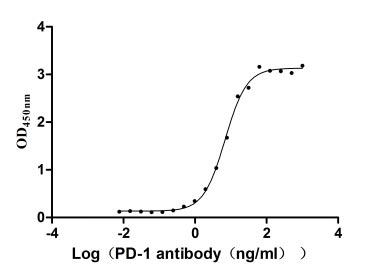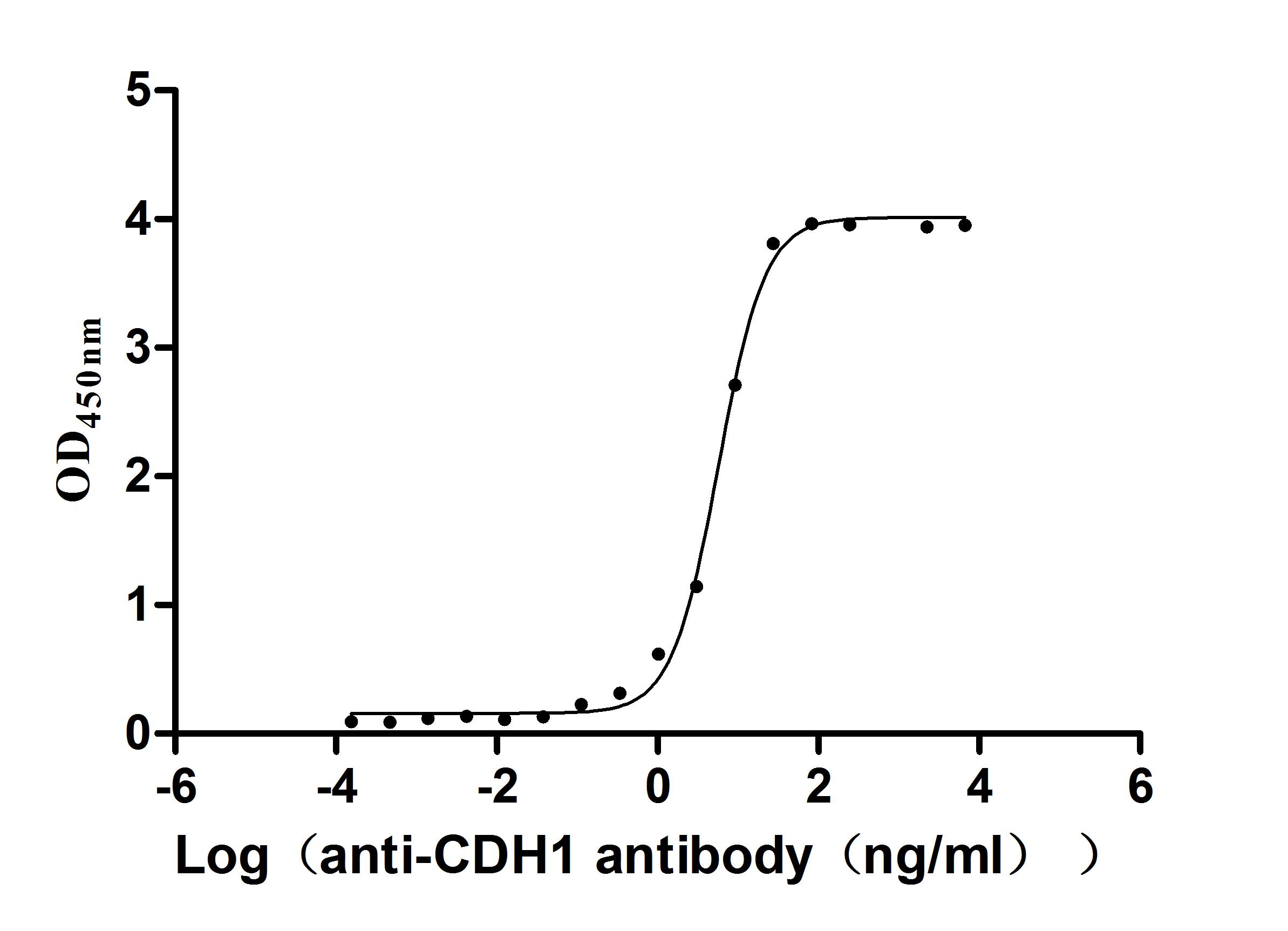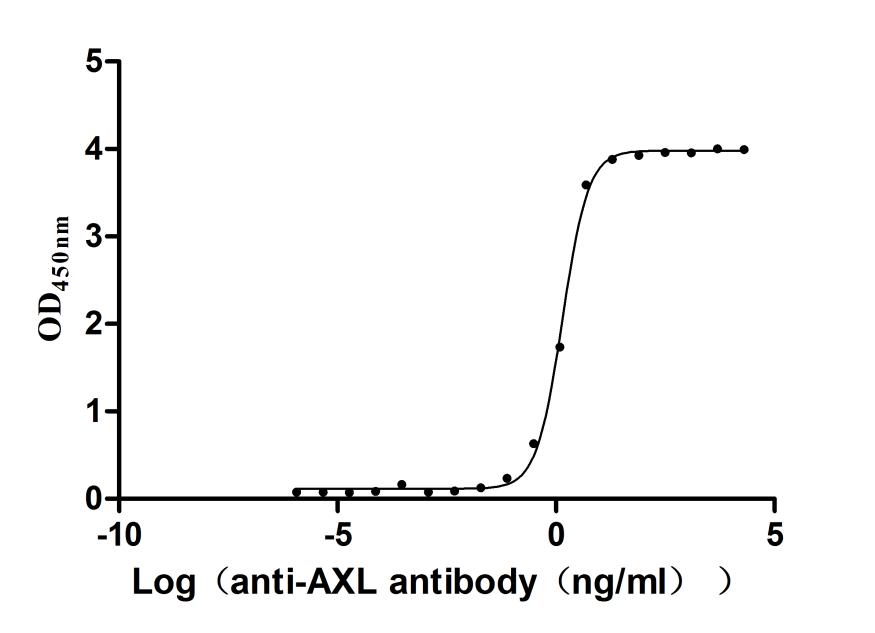Recombinant Mouse NAD (+) hydrolase SARM1 (Sarm1), partial
-
中文名称:小鼠Sarm1重组蛋白
-
货号:CSB-YP747471MO
-
规格:
-
来源:Yeast
-
其他:
-
中文名称:小鼠Sarm1重组蛋白
-
货号:CSB-EP747471MO-B
-
规格:
-
来源:E.coli
-
共轭:Avi-tag Biotinylated
E. coli biotin ligase (BirA) is highly specific in covalently attaching biotin to the 15 amino acid AviTag peptide. This recombinant protein was biotinylated in vivo by AviTag-BirA technology, which method is BriA catalyzes amide linkage between the biotin and the specific lysine of the AviTag.
-
其他:
-
中文名称:小鼠Sarm1重组蛋白
-
货号:CSB-BP747471MO
-
规格:
-
来源:Baculovirus
-
其他:
-
中文名称:小鼠Sarm1重组蛋白
-
货号:CSB-MP747471MO
-
规格:
-
来源:Mammalian cell
-
其他:
产品详情
-
纯度:>85% (SDS-PAGE)
-
基因名:Sarm1
-
Uniprot No.:
-
别名:Sarm1; Kiaa0524NAD(+) hydrolase SARM1; NADase SARM1; EC 3.2.2.6; NADP(+) hydrolase SARM1; EC 3.2.2.-; Sterile alpha and TIR motif-containing protein 1
-
种属:Mus musculus (Mouse)
-
蛋白长度:Partial
-
蛋白标签:Tag type will be determined during the manufacturing process.
The tag type will be determined during production process. If you have specified tag type, please tell us and we will develop the specified tag preferentially. -
产品提供形式:Lyophilized powder
Note: We will preferentially ship the format that we have in stock, however, if you have any special requirement for the format, please remark your requirement when placing the order, we will prepare according to your demand. -
复溶:We recommend that this vial be briefly centrifuged prior to opening to bring the contents to the bottom. Please reconstitute protein in deionized sterile water to a concentration of 0.1-1.0 mg/mL.We recommend to add 5-50% of glycerol (final concentration) and aliquot for long-term storage at -20℃/-80℃. Our default final concentration of glycerol is 50%. Customers could use it as reference.
-
储存条件:Store at -20°C/-80°C upon receipt, aliquoting is necessary for mutiple use. Avoid repeated freeze-thaw cycles.
-
保质期:The shelf life is related to many factors, storage state, buffer ingredients, storage temperature and the stability of the protein itself.
Generally, the shelf life of liquid form is 6 months at -20°C/-80°C. The shelf life of lyophilized form is 12 months at -20°C/-80°C. -
货期:Delivery time may differ from different purchasing way or location, please kindly consult your local distributors for specific delivery time.Note: All of our proteins are default shipped with normal blue ice packs, if you request to ship with dry ice, please communicate with us in advance and extra fees will be charged.
-
注意事项:Repeated freezing and thawing is not recommended. Store working aliquots at 4°C for up to one week.
-
Datasheet :Please contact us to get it.
相关产品
靶点详情
-
功能:NAD(+) hydrolase, which plays a key role in axonal degeneration following injury by regulating NAD(+) metabolism. Acts as a negative regulator of MYD88- and TRIF-dependent toll-like receptor signaling pathway by promoting Wallerian degeneration, an injury-induced form of programmed subcellular death which involves degeneration of an axon distal to the injury site. Wallerian degeneration is triggered by NAD(+) depletion: in response to injury, SARM1 is activated and catalyzes cleavage of NAD(+) into ADP-D-ribose (ADPR), cyclic ADPR (cADPR) and nicotinamide; NAD(+) cleavage promoting cytoskeletal degradation and axon destruction. Also able to hydrolyze NADP(+), but not other NAD(+)-related molecules. Can activate neuronal cell death in response to stress. Regulates dendritic arborization through the MAPK4-JNK pathway. Involved in innate immune response: inhibits both TICAM1/TRIF- and MYD88-dependent activation of JUN/AP-1, TRIF-dependent activation of NF-kappa-B and IRF3, and the phosphorylation of MAPK14/p38.
-
基因功能参考文献:
- Sarm1 deletion, but not Wld(S), confers lifelong rescue in a mouse model of severe axonopathy. PMID: 28978465
- This study extends the role of Sarm1 to axon degeneration seen in peripheral neuropathies and identifies it as a likely target for therapeutic development. PMID: 28485482
- SARM1 deletion restrains non-alcoholic fatty liver disease induced by high fat diet (HFD) in mice. PMID: 29454967
- we identify a physical interaction between the autoinhibitory N terminus and the TIR domain of SARM1, revealing a previously unrecognized direct connection between these domains that we propose mediates autoinhibition and activation upon injury. PMID: 27671644
- Using steady-state and flux analysis of NAD(+) metabolites in healthy and injured mouse dorsal root ganglion axons, we find that rather than altering NAD(+) synthesis, NMNAT1 instead blocks the injury-induced, SARM1-dependent NAD(+) consumption that is central to axon degeneration. PMID: 27735788
- demonstrate that the NADase activity of full-length SARM1 is required in axons to promote axonal NAD+ depletion and axonal degeneration after injury. PMID: 28334607
- Genetic deletion of SARM1 decreases axonal degeneration in a mouse model of neuropathy. PMID: 27797810
- SARM is a potential regulator of sepsis-induced splenocyte apoptosis. PMID: 27590237
- Sarm1(-/-)mice developed fewer Beta-amyloid precursor protein aggregates in axons of corpus callosum after traumatic brain injury. PMID: 26912636
- SARM1-induced depletion of NAD(+) may explain the potent axon protection in Wallerian degeneration slow (Wld(s)) mutant mice. PMID: 25908823
- The findings suggest that Sarm1 regulates social behaviors and cognition. PMID: 24321214
- knock-outs display altered inflammatory cytokine expression pattern in the brain neurons PMID: 23751821
- Therefore, Sarm1 functions downstream of ROS to induce neuronal cell death and axon degeneration during oxidative stress. PMID: 25009267
- this study identifies a new role for SARM in CCL5 expression in macrophages. PMID: 24711619
- Wild-type LPS is able to upregulate SARM and to prevent SIRPalpha downregulation. PMID: 23836818
- These results indicate that SARM plays an integral role in the dismantling of injured axons PMID: 23946415
- data demonstrate SARM plays a role in neurodegeneration during viral CNS infection; in addition, SARM plays a positive role in cytokine production; data suggest SARM is crucial for CNS injury and cytokine production in the CNS and may provide a link between neurodegeneration and the innate immune response PMID: 23749635
- Results presented in this study, for the first time, show that KA-mediated upregulation of SARM1 protein promotes Wallerian-like degeneration of retinal ganglion cells and their axons. PMID: 23518770
- severed mouse Sarm1 null axons exhibit long-term survival both in vivo and in vitro, indicating Sarm1 prodegenerative signaling is conserved in mammals; results provide direct evidence that axons actively promote their own destruction after injury and identify dSarm/Sarm1 as a member of an ancient axon death signaling pathway PMID: 22678360
- The N-terminal 27 amino acids (S27) of SARM, which is hydrophobic and polybasic, acts as a mitochondria-targeting signal sequence, associating SARM to the mitochondria. The S27 peptide has an inherent ability to bind to lipids and mitochondria. PMID: 22145856
- Burkholderia pseudomallei modulates macrophage defense mechanisms by upregulating SARM, thus leading to the suppression of IFN-beta and iNOS needed for bacterial elimination PMID: 21555400
- Sarm1, a negative regulator of innate immunity, interacts with syndecan-2 and regulates neuronal morphogenesis. PMID: 21555464
- SARM functions to restrict viral infection and neuronal injury in a brain region-specific manner, possibly by modulating the activation of resident CNS inflammatory cells. PMID: 19587044
显示更多
收起更多
-
亚细胞定位:Cytoplasm. Cell projection, axon. Cell projection, dendrite. Cell junction, synapse. Mitochondrion.
-
组织特异性:Widely expressed in the brain and neurons (at protein level). Expressed in photoreceptor cells of the neural retina.
-
数据库链接:
KEGG: mmu:237868
UniGene: Mm.210332
Most popular with customers
-
Recombinant Human Programmed cell death protein 1 (PDCD1), partial (Active)
Express system: Mammalian cell
Species: Homo sapiens (Human)
-
Recombinant Human E3 ubiquitin-protein ligase ZNRF3 (ZNRF3), partial (Active)
Express system: Mammalian cell
Species: Homo sapiens (Human)
-
Recombinant Mouse Microtubule-associated protein tau (Mapt) (Active)
Express system: Mammalian cell
Species: Mus musculus (Mouse)
-
Recombinant Macaca mulatta Semaphorin-4D isoform 1 (SEMA4D), partial (Active)
Express system: Mammalian cell
Species: Macaca mulatta (Rhesus macaque)
-
Recombinant Human Cadherin-1(CDH1),partial (Active)
Express system: Mammalian cell
Species: Homo sapiens (Human)
-
Express system: Mammalian cell
Species: Homo sapiens (Human)
-
Recombinant Human Tyrosine-protein kinase receptor UFO(AXL),partial (Active)
Express system: Mammalian cell
Species: Homo sapiens (Human)



















